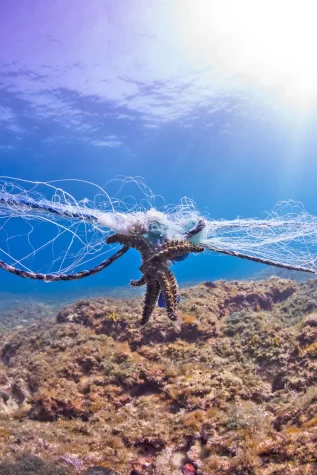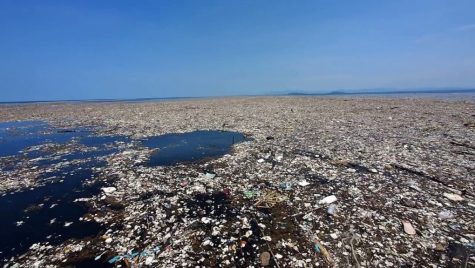Trash Island
May 23, 2023
A secluded getaway far off the coast of California. Hawaii? No. Instead, trash island. Trash Island, also known as The Great Pacific Garbage Patch, is a patch of waste between California and Hawaii. There are other patches, but this is by far the biggest. The vortex of debris and waste spans an estimated 1,600,000 square kilometers or 620,000 square miles. That’s bigger than the countries of Madagascar and Egypt combined. Scientists have also estimated that it is between 5 to 2,000 meters deep. Plastic Soup Foundation reports that the production of plastic will increase by 40% in the next ten years. “By 2025, oceans will carry more plastic than fish (by weight).”
THE CLEANUP

The Ocean Cleanup is a non-profit organization working on reducing GPGP. The organization says, “92% of the debris consists of objects larger than 0.5 cm, and ¾ of the total mass is made of macro- and mega plastics. Microplastics represent 94% of the total.” Most garbage enters the oceans by wind, rivers, sewers, and abandoned vessels. Fishing also significantly contributes to the amount of trash piling up. Gear like nets and buoys are tossed and lost every single day. Some of the debris dates back to the 70s. At the same time, some see the literal landfill on the water as a permanent mark made by humans to be left on this planet. There are still ways to slow the process of this patch growing. You can help by properly recycling your waste, reducing single-use plastics, using more paper (straws, bags, etc.), and volunteering at beach cleanups to prevent even further debris from being pulled into the sea. Buying more Farm-raised seafood can also contribute to less fishing waste.
OCCURRING DANGERS

Scientists have recently discovered an ecosystem living on the debris. A new species of shrimp-like anthropods. These organisms thrive on the waste and are likely eating each other too. Scientists don’t know much about the new organisms yet, but they believe they can threaten marine life and humans. You see, the marine life living beneath or around the patch need to eat. When they eat their prey, microplastics have already contaminated their food. As well as those new organisms. The fish and other life move up the food chain, and we then consume the caught sea life. Those bags and bottles we didn’t recycle are in our bodies, and maybe even diseases those little creatures carry from the newly discovered organisms.
Can you help reduce your use of plastics and the amount of plastic invading our marine friend’s homes? If everyone at Santiago would reduce their plastics and use more paper. You can contribute to slowing the process of the debris growing. You don’t have to say no to plastic altogether. It just isn’t possible (yet). So free up a Sunday, get out, and volunteer at a beach cleanup. Spread the word about this growing matter. Our planet has many years ahead, but they are counting down. I encourage everyone to take more time and research the good you can be doing if you take the extra steps to make our planet more sustainable. What kind of world will you be leaving our children?